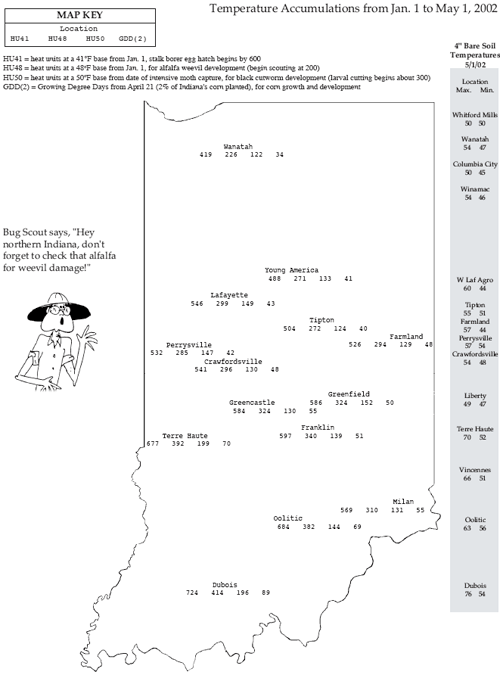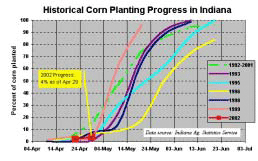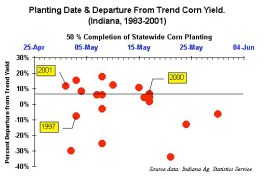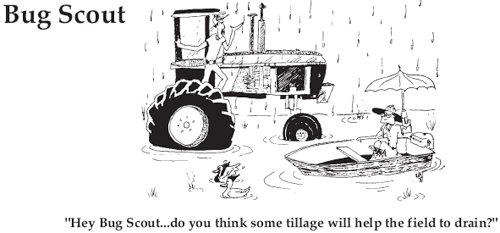Pest & Crop Newsletter
|
|||||||||||||||||||||||||||||||||||||||||||||||||||||||||||||||||
Black Cutworm Moth Arrival and Corn Planting- (John Obermeyer, Rich Edwards, and Larry Bledsoe)
Many factors determine whether or not black cutworms pose a threat to Indiana’s corn crop. Variables such as time of moth arrival, moth numbers, temperature, early weed growth, past cropping history, tillage or herbicide timing, planting date, corn emergence, natural moth and larval mortality, and beneficial organisms influence black cutworm populations. Is the stage set for a cutworm outbreak? Yes and No! So far, through the efforts of our black cutworm pheromone trap cooperators scattered throughout the state, we know that black cutworm moth numbers have increased significantly over the past week or so (see “Black Cutworm Trap Comparison 1999 - 2002”). Typically the late April moth flight is the one that accounts for most of the damage we see in Indiana. The trend of using post-applied herbicides with little to no tillage prior to planting has provided an abundance of winter annual weeds in many fields. These “weedy” fields are generally preferred by black cutworm moths for egg laying. Research has shown that black cutworm larvae will starve when destruction of their feeding sites occurs 2-3 weeks prior to corn emergence. This year, little to no tillage may occur once producers are able to get into fields. Planting directly into winter annuals treated with a burn-down herbicide may force the cutworms to feed on corn seedlings as they emerge. Refer to this week’s “Weather Update” for heat unit accumulations. Corn emerging or in the seedling stage at approximately 300 heat units (base 50?F) accumulated from the time of an intensive moth capture is at the greatest risk for damage to occur. The small amount of corn that was planted in early to mid April may be out of harm’s way, but should still be checked, however. Corn that emerges the second week of May might be at the right stage of growth for damage to be observed. However, no matter the size of the corn, watch for larval feeding activity on leaves and cutting of plants by 3rd + instar larvae. Remember that plants cut off at or below the growing point will not come back. Our continuing, unwavering, and steadfast recommendation is to not treat cornfields with an insecticide for black cutworm before or at planting. Rather, scout fields with emerged corn at the time when damage should be present and determine if a foliar insecticide is needed. Watch for black cutworm management guidelines in an upcoming issue(s) of Pest&Crop.
Perfect Weather for Seed Damaging Insects– (John Obermeyer, Rich Edwards, and Larry Bledsoe)
For the limited number of corn and soybean fields that have been planted, emergence has been painfully slow. Much of the seed has been sitting in the soil for over two weeks, a situation perfect for seed attacking insects. As the crop slowly appears, one may notice uneven emergence. Field inspections may reveal seed or sprouts that have been invaded or feed upon by seedcorn maggots, seedcorn beetles, and/or wireworms. If the culprit is no longer present, one can usually tell by the type of damage as to which pest was present. Damage from these insects varies from tunneling into the seed to being completely hollowed out. Obviously, at this point there are no rescue treatments. Remember, there are several other factors that can lead to stand reductions ranging from planter malfunctions, seedling diseases, and pesticide damage to seeds. If replanting becomes necessary where insects caused the problem, seed treatments or insecticide decisions should be based on several factors: the damaging insect, is it still present and actively feeding, predicted soil temperatures and plant growth rate, and insecticide restrictions. Replanting corn where wireworms are present requires the use of an in-furrow soil insecticide labeled for wireworm control. These critters can be active well into June, justifying such a treatment. If a soil insecticide was used at planting, be aware of restrictions as to the amount of product that can be applied per season as stated on the label (see last week’s Pest&Crop article, “Replanting Corn and Soil Insecticide Restrictions”). There are no soil insecticides or effective seed treatments labeled for wireworm control in soybean. When replanting corn or soybean for seedcorn maggot and/or seedcorn beetle consider the soil temperature. If conditions are expected to remain cool and crop emergence may take over a week, then an insecticide seed treatment applied at planting is likely a wise investment (refer to Pest&Crop # 4, April 12, 2002, “What About Seed Attacking Insects?”). When warm soil temperatures are present or expected, then seed treatments may not be necessary.
Corn Planting, Rootworms, and Soil Insecticides– (John Obermeyer, Rich Edwards, and Larry Bledsoe)
We now have a new weather predictor! You’re familiar with woollybear caterpillars and their bandwidths being used to anticipate the severity of winter’s temperatures. Now, western corn rootworm beetle numbers in the summer can be used to predict next spring’s planting conditions! Since we’ve been monitoring the western corn rootworm presence in soybean fields, Indiana’s had two extremely high beetle years … 1997 and 2001. The following springs have been wet with extremely slow crop planting progress. In 1998, the beetle numbers plummeted from the year before, indicating that many hatching larvae either starved from lack of corn roots or drowned from saturated soil conditions. Could 2002 be a repeat? Delayed planting is actually a valid pest management technique to avoid economic rootworm damage to corn roots, although we do not recommend it. Overwintering rootworm eggs begin to hatch around mid to late May, and even into early June, in Indiana depending on soil temperatures. Newly hatched larvae have a short period of time to find corn roots before they perish from starvation. This hatching goes on for over a period of weeks. Therefore, if corn planting didn’t begin until about the second week of June, rootworm would be of little threat to most corn in Indiana. Believe or not, producers are unwilling to follow this management strategy! As planting picks up and everything becomes extremely hectic, producers will consider all timesaving measures, e.g., no-till, side-dress nitrogen, etc., to get corn seed into the ground. Is omitting the soil insecticide a viable option at this time … NO! Areas of the state that are at high risk for rootworm larval activity (refer to Pest&Crop #1, March 1, 2002) should still apply soil insecticides. The risk of rootworm damage does not begin to diminish until late May or early June, depending on soil temperatures. DO NOT broadcast granular or liquid insecticides for rootworm control. Not only is this off label, it is too expensive to provide good economic returns. Soil insecticides may be banded at the base of the plant during “cultivation-time.” Liquid insecticides, Furadan 4F and Lorsban 4E, can be mixed with 28% (UAN) nitrogen and directed at the plants base with drop nozzles. Compatibility checks should be made before tank mixing and application. A light cultivation, if possible, or rainfall will help the product move into the root zone. The good news for those fields yet to be planted is that rootworm insecticides should perform adequately this year, if soil insecticide applicators are calibrated correctly! Remember, the closer you apply them to rootworm hatch the better they normally work.
Slug-ish Planting– (John Obermeyer, Rich Edwards, and Larry Bledsoe)
With planting going at a “snail’s” pace this spring, there will be a great temptation to plant fields before soils are in their optimal condition. Over the last decade or so, build-up of slug populations has occurred in various areas of the state. The mild fall/winter conditions and the present wet soils have created good conditions for slug survival this spring. You might say a “slugfest” is just ready to happen.
Most damage and stand losses by slugs occur when fields are too wet to plant and seed slots are not properly closed. In this situation, slugs can be found feeding on the seedlings within the slot, day or night. Control of slugs is difficult, if not impossible at this point. Granular and liquid insecticides applied during or post-planting are ineffective against slugs, as they slime over them. Obviously, once the growing point of corn or soybean is injured, plant recovery is unlikely. Where slugs have been a problem in years past, tillage is a possible management strategy. Disrupting the soil environment exposes slug eggs and juveniles, destroying many and/or discouraging population growth. This is not an option on highly erodible land (HEL). A couple metaldehyde-pelleted baits are labeled and available for use. Spreading the mini-pellets evenly over the whole field or just “hot spots” is a challenge; a commercial mechanical dispenser is one possibility. Field trials at Ohio State have shown encouraging results when the pellets are evenly distributed. With the significant cost and difficulty of application, consider these baits only as a last resort to protect crop stands in high slug populated areas.
Watch for Nematode Damage to Corn and Soybean– (Jamal Faghihi and Virginia Ferris) The cool and wet weather that we are experiencing creates an ideal condition for needle nematode to cause early season stunting and yellowing of corn grown in sandy, light textured soils. This nematode causes extensive damage when corn seedlings are small and have relatively limited root systems. During this period, corn plants remain stunted and often have yellowed foliage. Once soil temperatures rise, and the surface soil becomes hot and dry, needle nematode stops feeding and disappears, and corn seedlings resume more normal growth. If you suspect needle nematode damage in your corn fields, samples collected up to 2 months after planting should still contain the nematode. Collect suspected plants with the adjacent soil and send them to the nematology laboratory at Purdue University for analysis. Samples must be kept cool and prevented from drying. The soybean cyst nematode (SCN) continues to be a major pest of soybean. If a pattern of poor soybean growth or unexplained declining yield has been observed, SCN could be the problem. If SCN is known to be present, its population level has to be monitored. Soil samples for SCN can be collected at any time of the year; however, white females may be observed on soybean roots about 4-6 weeks after planting. The Indiana Soybean Board is continuing to cover the cost of nematode analysis for soybean (up to 10 samples/grower/year). If you have questions about these, or any other kinds of nematodes, you can call us at 765/494-4611. If you are uncertain about whether plant parasitic nematodes are the cause of some type of unsatisfactory crop growth, you might consider sending a soil sample to us at: Nematology Laboratory, Department of Entomology, Purdue University, West Lafayette, IN 47907-1158.
|
|||||||||||||||||||||||||||||||||||||||||||||||||||||||||||||||||
Poised fr the Pre's– (Glenn Nice and Thomas Bauman) The tractor is ready to go. The spray rig is ready to go. The planter is ready to go, but the weather is not. Like racers poised at the starting line many Indiana producers are lined up and ready to go. With the weather being the way it is you may find yourself more concerned about getting the crop in than worrying about applying a PRE. However, if a PRE is still part of the plan, but you may find it going out once the crop has emerged, there are some soil applied options to think about. Below is a table of some of the preemergent products you can used to get some residual activity after crop emergence.
Senecio and Indiana– (Glenn Nice and Thomas Bauman) In the past, mustards were given the reputation of turning fields yellow; however, this year it may be ragworts and groundsels doing all the work. We have been getting reports, that the amount of Senecio seems to be higher this year than seen before. In one report, cattle were feeding on the Senecio in a pasture.
Senecio spp. are members of the Aster family (compositae/Asteraceae). In Indiana we generally have common groundsel (Senecio vulgaris) and golden ragwort (S. aureus), an erect winter or summer annual. The young leaves can be variable being lanceolate to deeply lobed. Mature leaves are generally have deeply lobed margins and are alternately placed on the stem. Stems are highly branched, erect and smooth. The lower stems can sometimes root at the lower nodes. Yellow disk like flowers can be seen from April to October. However, in Indiana we usually see the flowers in the early spring. Flower heads are 0.4 of an inch in diameter (see figure 1). The seed are in a reddish brown achene. Each achene has a pappus for wind dispersal of seed. Seed heads can look like small dandelion seed heads. It can be told apart from mustards in that mustards have four petals per flower, Senecio have several petal like ray flowers. Common groundsel can be found along roadsides, in pastures, and in wet nutrient rich areas. It grows best in cool wet conditions and will die out in periods of hot and dry conditions, as is often found in an Indiana summer. Senecio species can be toxic to cattle and horses. Common groundsel, not as toxic as its cousin to the West, tansy ragwort (Senecio jacobaea), common groundsel can still produce toxic alkaloids. Poisoning is most often chronic, taking several weeks to show symptoms. Senecio poisoning is called “seneciosis” or “pictou disease.” Symptoms in cattle can include; scaled noses, rough coats, listlessness, and a decreased appetite with digestive problems (diarrhea or constipation). In severe cases, cattle may be jaundiced and/or photosensitive. Calves can develop swollen jaws. Horses can become nervous and have the “sleepy staggers,” bumping into objects or becoming entangled in fences. Long term exposure can cause liver damage. To prevent seneciosis, learn to identify senecio species in the pastures and in hay. Remove contaminated hay and avoid feeding on senecio infested pastures. Senecio spp. can be a problem where tillage is not used. Traditionally the first line of control would be to use 2,4-D products at the rosette stage. However, in some cases control has been somewhat dissatisfying. Applications of dicamba (Banvel, Sterling, and Clarity) on larger plants or once the stem is elongating has given some control. Glyphosate products (Roundup Ultra Max, Touchdown, Glyphomax Plus, many) are also effective. However, in a pasture or forage, these applications will cause injury to the desired crop and can only be used as spot applications (treat only 1/10 of an acre at a time). In glyphosate resistant crops this would be a great choice. Sulfonylureas such as chlorimuron (canopy XL labeled for PRE applications before soybean) and metsulfuron (Ally, not labeled in Indiana) have some effect on ragworts. Due to the lack of effective herbicides, there has been some research on the use of biological controls. In the case of ragworts, insects have been investigated as possible control mechanisms. Much of the research has focused on the cinnabar moth (Tyria jacobaeae) and the ragwort flea beetle (Longitarsus flavicornis and L. jacobaeae).
|
|||||||||||||||||||||||||||||||||||||||||||||||||||||||||||||||||
Leaf Blotch of Wheat– (Gregory Shaner)
Leaf blotch is a major disease of wheat in Indiana. The disease is favored by wet weather, which certainly describes April throughout the state. It’s not so much the total amount of rainfall that influences leaf blotch development as the number of days of rain, and we’ve had a lot of those. However, it has also been cool. Cool weather holds the disease in check, which is why it is difficult to predict whether leaf blotch will be severe this year. Except for a few days during mid April, it has been too cold for leaf blotch to develop. P is the predicted percentage of leaf area blighted (a value between 0 and 100 %) 26 days after heading, X1 is the number of 2-day dry periods for the period March 25 through May 4. X2 is the number of 2-day periods with minimum temperature less than 45°F for April 4 through May 4. Below are some data from the Purdue Agronomy Research Center to illustrate how X1 and X2 are calculated.
To run the model, values of X1 need to be summed from March 25 through May 4 and values of X2 need to be summed from April 4 through May 4. The greater the value of X1 and X2, the less severe leaf blotch is predicted to be. At the time of writing, I do not have data for the first 4 days of May, so cannot yet run the model.
|
|||||||||||||||||||||||||||||||||||||||||||||||||||||||||||||||||
Perspective on Planting Dates & Corn Yield Potential- (Bob Nielsen) Conventional wisdom says that the prime planting window for achieving optimum corn yields in much of Indiana opens about April 20 and closes about May 10. This ‘window’ opens about one week later across the northern tier of counties and about one week earlier across the southern tier of counties. According to the Indiana Agricultural Statistics Service <http://www.nass.usda.gov/in>, only four percent of the state’s corn crop was planted as of April 28. That pace puts us in an unenviable dead heat with five of the slowest corn planting years out of the last ten. That leaves a lot of corn to be planted between now and the 10th day of May before that prime planting window closes.
What are the consequences of planting corn after May 10? How important a predictor of statewide corn yield is planting date anyway? Does late planting in and of itself guarantee lower than normal yields? Interestingly enough, the planting date effect on yield is somewhat paradoxical. If one reviews the data for average statewide planting dates and corn yield for the past nineteen years, there is NOT a strong relationship between the date by which half of the state’s corn is planted and the consequent statewide average corn grain yield. In fact, less than 10 % of the variability in statewide corn grain yield during the past nineteen years is related to planting date. So what’s the deal? Why do agronomists preach about the importance of timely planting and yet the statewide statistical data do not appear to substantiate this importance? Let me try to explain.
The bad news is that corn grain yield potential does indeed decline by one to two bushels per acre per day of delayed planting after about May 10. That means, for example, that corn planted on May 30 would be expected to yield from 20 to 40 bushels less than corn planted before May 10. Delayed planting beyond early May will typically result in lower corn yields because of a number of factors, including a shorter growing season, insect & disease pressure, and moisture stress during pollination. The good news is that planting date is but one of many yield influencing factors (YIFs) for corn. All of the other YIFs interact with planting date to determine the overall yield potential for any given year. In other words, although we know that early-planted corn will usually yield more than later-planted corn, the exact or absolute yield level is dependent on a host of other YIFs. Therefore, it is possible for early-planted corn in one year to yield more than, less than, or equal to later-planted corn in another year depending on the exact mix of YIFs for each year. That is the reason why statewide average corn grain yields frequently vary by plus or minus 10% from the expected trend yield from year to year. For example, the crop years 1997 and 2000 represent early and late planting dates in Indiana. The date by which half of the state’s corn crop was planted in 1997 and 2000 was May 3 and May 17, respectively. Yet, the earlier planted 1997 crop yielded 7.5% BELOW trend yield for that year and the later planted 2000 crop yielded 6.6% ABOVE trend yield according to the Indiana Agricultural Statistics Service. Bottom Line: Don’t carried away about the influence of planting date on total corn production. While important, planting date is only one of many yield-influencing factors for corn. Don’t forget, this and other timely information about corn can be viewed at the Chat ‘n Chew Café on the World Wide Web at <http://www.kingcorn.org/cafe>. For other information about corn, take a look at the Corn Growers’ Guidebook on the World Wide Web at <http://www.kingcorn.org/>.
Ten Tillage Rules in a Wet Spring- (Tony J. Vyn) Tillage decisions that seemed to be appropriate in the relatively dry planting seasons of the last three springs need to be adjusted in light of recent wet soil conditions before and during the optimum corn planting period. Here are 10 “rules” that farmers should consider in a wet spring:
Additional information on recent research experiences with “single-pass tillage systems for corn and soybeans on loam soils in Indiana” is available at <http://www.agry.purdue.edu/ext/pubs/AGRY-02-01.pdf>.
|
|||||||||||||||||||||||||||||||||||||||||||||||||||||||||||||||||

|
|||||||||||||||||||||||||||||||||||||||||||||||||||||||||||||||||







